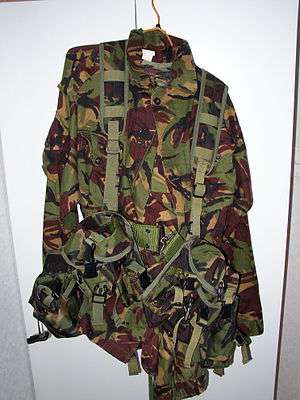New Zealand disruptive pattern material

The New Zealand disruptive pattern material, also known as the New Zealand DPM, was the official camouflage uniform used by the New Zealand Armed Forces until 2013. It has since been replaced with a new pattern called Multi Terrain Camouflage.[1] New Zealand DPM is very similar to the British Disruptive Pattern Material.
Historically, New Zealand's armed forces used British DPMs, with the first issues of 1968 Pattern smock and trousers being made in 1980. These were replaced with the first of the New Zealand pattern DPM in 1984–1985, and there have been several iterations since. In the mid-1990s a quantity of British windproof smocks were purchased as the indigenously developed DPM camouflage woollen "Swanndri" had never really found favour due to its weight (especially when wet), bulk and impractical cut.
New Zealand DPM is identical to Dutch DPM in colouration with the exception of the dithering which is absent in the Dutch pattern.
Use
This dress was worn by all ranks of the New Zealand Army and New Zealand Defence Force for most forms of training and on operations. Medals and medal ribbons were never worn with this uniform as its main purpose was camouflage. Those deployed on operations and peacekeeping missions wear a black and white Kiwi badge and New Zealand flag badge on their left arms to identify them as New Zealanders, as well as multinational force identification badges and headwear as appropriate, including the United Nations, International Security Assistance Force or Multinational Force and Observers badges. When worn in the field, the sleeves were rolled down, and camouflage face paint was worn.
1997 Pattern
After a series of cheaply made shirt and trouser iterations, a new pattern was issued in 1997; it resembled in DPM colour and cut the British jungle DPM shirt and trousers used until the late 1990s which were lighter in colour than the British "Combat Soldier 95" pattern. Of high-quality manufacture, the shirt and trousers feature double knees, elbows and seat. Rank slides are worn on the shoulders. A lightweight 100% cotton DPM windproof smock is issued, which has a rank slide on the front, covered buttons and an integral hood.
2008 Pattern
In late 2008, New Zealand Army commenced issue of a new combat uniform. It was still New Zealand DPM camouflage, but made in rip-stop material and in a new cut which was somewhat similar to the latest style of Australian DPCU, US ACU and British PCS MTP uniforms, in that the patch pockets on the shirt are replaced by internal, vertical closure pockets and the shirt is cut for wear outside the trousers, and a camouflaged rank slide is worn on the front tab.
New Zealand Desert DPM
The first contingents deployed to Afghanistan wore the 1997 pattern standard temperate DPM. A desert version of the 1997 pattern uniform first appeared in 2003 with the deployment to Iraq. The pattern is very similar to British two-colour desert DPM. A desert DPM version of the 2008 combat uniform was issued for use in Afghanistan, the Sinai and Lebanon. As of 2014 the pattern has been replaced with the New Zealand Multi-Terrain Pattern. New Zealand Special Forces operating in Afghanistan have been using Multicam camo uniforms as with Australian, U.S and other allied forces.
New Zealand Multi Terrain Camouflage Uniform (MCU pattern)
On July 27, 2012, the New Zealand Army formally announced the new Multi Terrain Camouflage Uniform will replace the NZDPM and NZDDPM patterns.[2] The pattern is a variant of the Ghostex family of camouflage patterns by Canadian company Hyperstealth Biotechnology Corp. The initial rollout phase for the MCU uniform was concluded on June 16, 2013 with 1st NZArmy Brigade being issued it.[3] Completion of the transition occurred in 2014.[4]
See also
- Smock Windproof DPM
- Canadian Para Smock
- DPM Parachute Smock
- Disruptive Pattern Camouflage
- Disruptive Pattern Material
References
- ↑ http://www.hyperstealth.com/NZ-MCU/
- ↑ http://soldiersystems.net/2012/07/24/multi-terrain-camouflage-uniform-new-zealand-troops/
- ↑ http://www.nzdf.mil.nz/news/media-releases/2013/20130620nanail.htm NZ Army's New And Improved Look - June 20, 2013
- ↑ http://www.army.mil.nz/about-us/who-we-are/structure/uniforms/multi-terrain-camo-uniform.htm
External links
- An example of New Zealand '84 Pattern' DPM
- NZ An later example of New Zealand '84 Pattern' DPM
- Soldiers wearing New Zealand DPM
- New Zealand and Australian camouflage patterns
- http://www.hyperstealth.com/NZ-MCU/